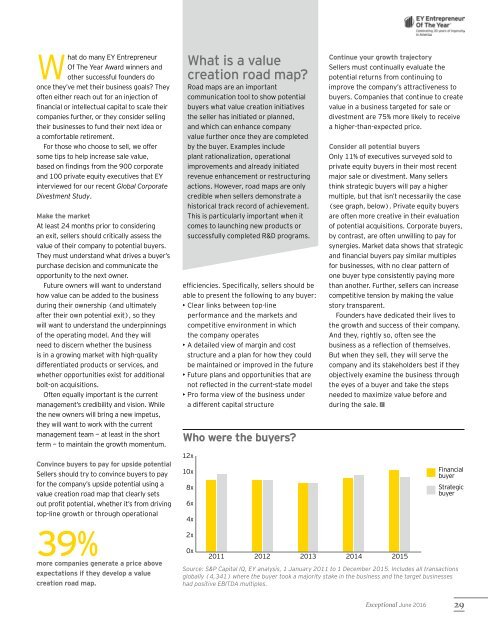Exceptional
ey-exceptional-30th-anniversary-issue
ey-exceptional-30th-anniversary-issue
You also want an ePaper? Increase the reach of your titles
YUMPU automatically turns print PDFs into web optimized ePapers that Google loves.
What do many EY Entrepreneur<br />
Of The Year Award winners and<br />
other successful founders do<br />
once they’ve met their business goals? They<br />
often either reach out for an injection of<br />
financial or intellectual capital to scale their<br />
companies further, or they consider selling<br />
their businesses to fund their next idea or<br />
a comfortable retirement.<br />
For those who choose to sell, we offer<br />
some tips to help increase sale value,<br />
based on findings from the 900 corporate<br />
and 100 private equity executives that EY<br />
interviewed for our recent Global Corporate<br />
Divestment Study.<br />
Make the market<br />
At least 24 months prior to considering<br />
an exit, sellers should critically assess the<br />
value of their company to potential buyers.<br />
They must understand what drives a buyer’s<br />
purchase decision and communicate the<br />
opportunity to the next owner.<br />
Future owners will want to understand<br />
how value can be added to the business<br />
during their ownership (and ultimately<br />
after their own potential exit), so they<br />
will want to understand the underpinnings<br />
of the operating model. And they will<br />
need to discern whether the business<br />
is in a growing market with high-quality<br />
differentiated products or services, and<br />
whether opportunities exist for additional<br />
bolt-on acquisitions.<br />
Often equally important is the current<br />
management’s credibility and vision. While<br />
the new owners will bring a new impetus,<br />
they will want to work with the current<br />
management team — at least in the short<br />
term — to maintain the growth momentum.<br />
Convince buyers to pay for upside potential<br />
Sellers should try to convince buyers to pay<br />
for the company’s upside potential using a<br />
value creation road map that clearly sets<br />
out profit potential, whether it’s from driving<br />
top-line growth or through operational<br />
39%<br />
more companies generate a price above<br />
expectations if they develop a value<br />
creation road map.<br />
What is a value<br />
creation road map?<br />
Road maps are an important<br />
communication tool to show potential<br />
buyers what value creation initiatives<br />
the seller has initiated or planned,<br />
and which can enhance company<br />
value further once they are completed<br />
by the buyer. Examples include<br />
plant rationalization, operational<br />
improvements and already initiated<br />
revenue enhancement or restructuring<br />
actions. However, road maps are only<br />
credible when sellers demonstrate a<br />
historical track record of achievement.<br />
This is particularly important when it<br />
comes to launching new products or<br />
successfully completed R&D programs.<br />
efficiencies. Specifically, sellers should be<br />
able to present the following to any buyer:<br />
• Clear links between top-line<br />
performance and the markets and<br />
competitive environment in which<br />
the company operates<br />
• A detailed view of margin and cost<br />
structure and a plan for how they could<br />
be maintained or improved in the future<br />
• Future plans and opportunities that are<br />
not reflected in the current-state model<br />
• Pro forma view of the business under<br />
a different capital structure<br />
Who were the buyers?<br />
12x<br />
10x<br />
8x<br />
6x<br />
4x<br />
2x<br />
0x<br />
2011<br />
Continue your growth trajectory<br />
Sellers must continually evaluate the<br />
potential returns from continuing to<br />
improve the company’s attractiveness to<br />
buyers. Companies that continue to create<br />
value in a business targeted for sale or<br />
divestment are 75% more likely to receive<br />
a higher-than-expected price.<br />
Consider all potential buyers<br />
Only 11% of executives surveyed sold to<br />
private equity buyers in their most recent<br />
major sale or divestment. Many sellers<br />
think strategic buyers will pay a higher<br />
multiple, but that isn’t necessarily the case<br />
(see graph, below). Private equity buyers<br />
are often more creative in their evaluation<br />
of potential acquisitions. Corporate buyers,<br />
by contrast, are often unwilling to pay for<br />
synergies. Market data shows that strategic<br />
and financial buyers pay similar multiples<br />
for businesses, with no clear pattern of<br />
one buyer type consistently paying more<br />
than another. Further, sellers can increase<br />
competitive tension by making the value<br />
story transparent.<br />
Founders have dedicated their lives to<br />
the growth and success of their company.<br />
And they, rightly so, often see the<br />
business as a reflection of themselves.<br />
But when they sell, they will serve the<br />
company and its stakeholders best if they<br />
objectively examine the business through<br />
the eyes of a buyer and take the steps<br />
needed to maximize value before and<br />
during the sale.<br />
2012 2013 2014 2015<br />
Financial<br />
buyer<br />
Strategic<br />
buyer<br />
Source: S&P Capital IQ, EY analysis, 1 January 2011 to 1 December 2015. Includes all transactions<br />
globally (4,341) where the buyer took a majority stake in the business and the target businesses<br />
had positive EBITDA multiples.<br />
<strong>Exceptional</strong> <strong>Exceptional</strong> January–June June 2013 2016<br />
29


